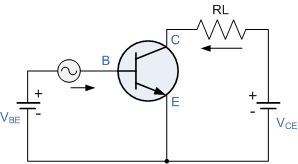transistor bias
I am using a NPN transistor to turn on a 100 ma LED string. I have the hook up with common emitter.
I understand this biases is 180 degree out of phase,,,I can understand that,,with a AC signal...but when I use this as a switch,,when base is on,,,load is on...Am I missing some general understanding here..
So Is this circuit OK for this purpose?
I understand this biases is 180 degree out of phase,,,I can understand that,,with a AC signal...but when I use this as a switch,,when base is on,,,load is on...Am I missing some general understanding here..
So Is this circuit OK for this purpose?



Comments
-Phil
Ahhh,,,Yea thats a better way of saying it...thanks.
...One other question...my load is 100 ma....say 12 volts...( the voltage don't matter as such)...but here is the question,,,I am using a tip 122,,,( gain 1000)..and good for 3 amps,,,,,I am using a 1 k resistor on the base( its driven from a 74hc595 shift register,,,,Is there any problem with going to such over kill,,,,I mean its saturated,,( 1000 gain it don't take much to saturate ),,and good for 3 amps when i am using 100ma,,,,Is there anything wrong,,,it seems to work,,,I want to be sure it will work....THANKS for the help
The load is 100 ma,,with 5 volt load and signal. i use a 50 ohm as a test load.
I was adusting a variable resistor on the base and watching when Vc-e gets low,,( .2 volts seems saturated),,,and no more Ic for more base current.
But then when I measure my base resistor...I get aprox 3.3 k NOT the 7.7K I calulate....Do I need to plot on a graph to actually see ..or is what I am doing with watching the meters acurate enought?
If i plot do I use a variable voltage on the base?
I want to find the base resistor,,,,so I know what Rb to use to saturate
usually I use common emitter bias..
And my math is like this,,,Ib =Ic /gain or 100ma/ 200= .5ma
So Rb is 4.4V/.5ma = 8.8 k ohm any help
2) The gain hFE is not well controlled in manufacture of transistors. The MMBT3904 data sheet specifies a gain range of 100 to 300, and again, that applies only to the non-saturated measurement conditions.
http://transistor.20m.com/transistor2.html
And the free Qucs circuit simulator...
(Windows Setup.exe type install 3/4 way down page)
http://qucs.sourceforge.net/index.html
Best instructions for Qucs here (Workbook)...
http://qucs.sourceforge.net/docs/workbook.pdf